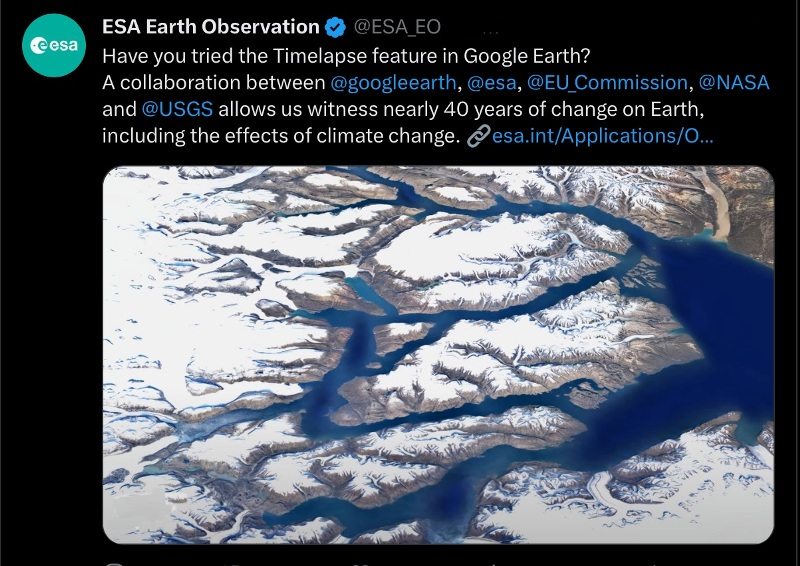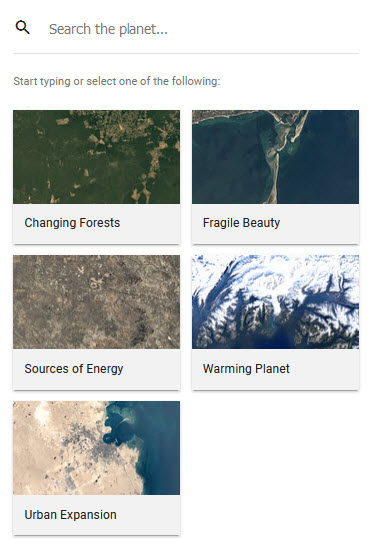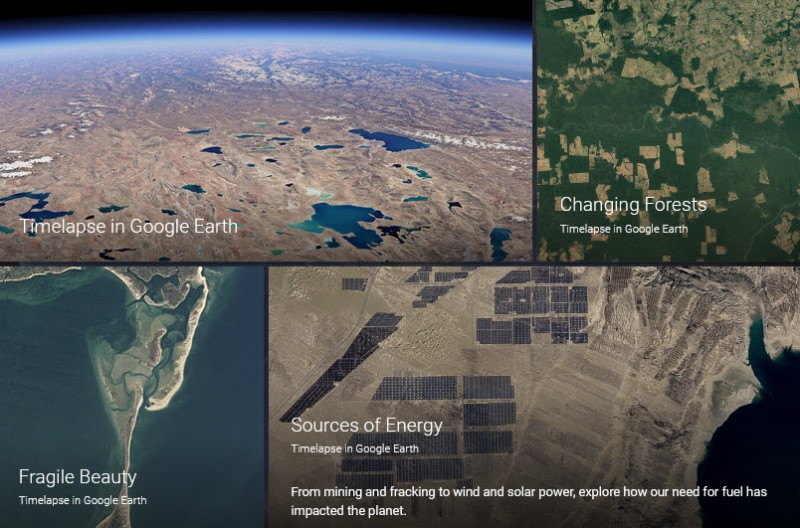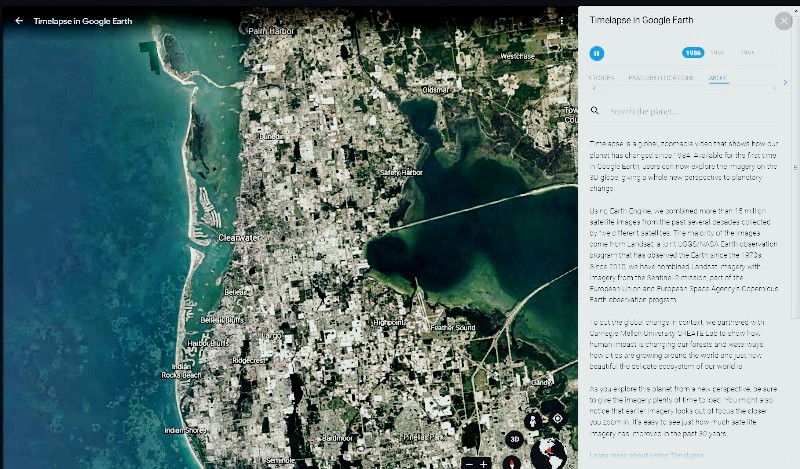Google Earth Timelapse: Difference between revisions
Siterunner (talk | contribs) No edit summary |
Siterunner (talk | contribs) No edit summary |
||
| (14 intermediate revisions by the same user not shown) | |||
| Line 6: | Line 6: | ||
<big><big><big>'''Timelapse from Google Earth'''</big></big></big> | <big><big><big>'''Timelapse from Google Earth'''</big></big></big> | ||
Welcome to Timelapse ! | <big>'''Welcome to Timelapse!'''</big> | ||
Director, Google Earth, Earth Engine & Outreach | '''Rebecca Moore, Director, Google Earth, Earth Engine & Outreach:''' | ||
''To explore Timelapse in Google Earth, go to [https://earth.google.com/web/@41.98486546,-87.91260108,195a,24634d,35y,0h,0t,0r/data=CjISMBIgNTQ0MGExNzMxYzI1MTFlYTk0NDM4YmI2ODk0NDUyOTciDG1haW5Ob1JhbmRvbQ g.co/Timelapse] — choose any place on the planet where you want to see time in motion.'' | |||
[[File:Timelapse.png]] | |||
<big>'''Time to Try the Timelapse app at Google Earth!'''</big> | |||
: With a Tip of our GreenPolicy360 hat to digital mapping, earth science visionaries | |||
::George E. Brown (Landsat) and Rebecca Moore (Google Earth Outreach) | |||
* https://www.greenpolicy360.net/w/George_E._Brown_Jr | https://www.greenpolicy360.net/w/Landsat_data_users_handbook | |||
* https://en.wikipedia.org/wiki/Rebecca_Moore_(scientist) | https://www.greenpolicy360.net/w/File:Rebecca_Google_Outreach.jpg | |||
🌎 | |||
* https://twitter.com/ESA_EO/status/1639911818230390786 | |||
* https://t.co/HILNINfsWb | |||
* https://www.esa.int/Applications/Observing_the_Earth/Satellite_imagery_key_to_powering_Google_Earth | |||
🌎 | |||
* https://www.greenpolicy360.net/w/Virtual_Earth | |||
* https://www.greenpolicy360.net/w/Google_Earth_Timelapse | |||
* https://www.greenpolicy360.net/w/Google_Earth | |||
* https://www.greenpolicy360.net/w/Category:Maps | |||
🌎 | |||
Launch Date: April 15, 2021 | |||
* http://goo.gle/timelapse | * http://goo.gle/timelapse | ||
| Line 54: | Line 98: | ||
''Making a planet-sized timelapse video required a significant amount of what we call “pixel crunching” in Earth Engine, Google's cloud platform for geospatial analysis. To add animated Timelapse imagery to Google Earth, we gathered more than 24 million satellite images from 1984 to 2020, representing quadrillions of pixels. It took more than two million processing hours across thousands of machines in Google Cloud to compile 20 petabytes of satellite imagery into a single 4.4 terapixel-sized video mosaic — that’s the equivalent of 530,000 videos in 4K resolution! And all this computing was done inside our carbon-neutral, 100% renewable energy-matched data centers, which are part of our commitments to help build a carbon-free future.'' | ''Making a planet-sized timelapse video required a significant amount of what we call “pixel crunching” in Earth Engine, Google's cloud platform for geospatial analysis. To add animated Timelapse imagery to Google Earth, we gathered more than 24 million satellite images from 1984 to 2020, representing quadrillions of pixels. It took more than two million processing hours across thousands of machines in Google Cloud to compile 20 petabytes of satellite imagery into a single 4.4 terapixel-sized video mosaic — that’s the equivalent of 530,000 videos in 4K resolution! And all this computing was done inside our carbon-neutral, 100% renewable energy-matched data centers, which are part of our commitments to help build a carbon-free future.'' | ||
''As far as we know, Timelapse in Google Earth is the largest video on the planet, of our planet. And creating it required out-of-this-world collaboration. This work was possible because of the U.S. government and European Union’s commitments to open and accessible data. Not to mention their herculean efforts to launch rockets, rovers, satellites and astronauts into space in the spirit of knowledge and exploration. Timelapse in Google Earth simply wouldn’t have been possible without NASA and the United States Geological Survey’s Landsat program, the world’s first (and longest-running) civilian Earth observation program, and the European Union’s Copernicus program with its Sentinel satellites.'' | ''As far as we know, Timelapse in Google Earth is the largest video on the planet, of our planet. And creating it required out-of-this-world collaboration. '''This work was possible because of the U.S. government and European Union’s commitments to open and accessible data. Not to mention their herculean efforts to launch rockets, rovers, satellites and astronauts into space in the spirit of knowledge and exploration. Timelapse in Google Earth simply wouldn’t have been possible without NASA and the United States Geological Survey’s Landsat program, the world’s first (and longest-running) civilian Earth observation program, and the European Union’s Copernicus program with its Sentinel satellites.''''' | ||
| Line 64: | Line 108: | ||
A tip of our GreenPolicy360 hat to '''[[George E. Brown Jr]]''' who envisioned the Landsat's mission and | A tip of our GreenPolicy360 hat to '''[[George E. Brown Jr]]''' who envisioned the Landsat's mission, the beginning of earth imaging and open access to the data and as a science leader in the US Congress supported, expanded and protected the earth science mission over the decades. The launch now, in April 2021, of Timelapse by Google Earth realizes a next step in George's decades-long quest to bring knowledge of our home planet to all citizens. | ||
* https://www.greenpolicy360.net/w/George_E._Brown_Jr | * https://www.greenpolicy360.net/w/George_E._Brown_Jr | ||
| Line 71: | Line 116: | ||
A salute to our friend and fellow [https://www.greenpolicy360.net/w/Bioneers Bioneer], [https://www.greenpolicy360.net/mw/index.php?title=Special%3ASearch&profile=default&search=rebecca+moore&fulltext=Search '''Rebecca Moore'''], who first proposed Google Earth Outreach and has led many follow on initiatives, now including Timelapse, utilizing the Landsat database and its decades of images to bring us an unprecedented vision of earth's changes over time. | |||
* https://www.greenpolicy360.net/w/File:Rebecca_Google_Outreach.jpg | |||
[[File:Rebecca Google Outreach.jpg]] | :::[[File:Rebecca Google Outreach.jpg]] | ||
[[File:G Earth Outreach.jpg]] | [[File:G Earth Outreach.jpg]] | ||
<big>'''More News on the Launch of Google Earth Timelapse:'''</big> | |||
* https://www.axios.com/google-earth-timelapse-show-climate-change-deforestation-bd9dced5-8438-4283-bdea-c1ca269c7a4c.html | |||
* https://www.bloomberg.com/news/articles/2021-04-15/google-earth-now-shows-decades-of-climate-change-in-seconds | |||
* https://www.cnn.com/videos/business/2021/04/15/google-earth-timelapse-zw-orig.cnn-business | |||
* https://www.commondreams.org/news/2021/04/16/new-google-earth-timelapse-feature-offers-devastating-view-climate-emergency | |||
* https://dailyhive.com/vancouver/google-earth-climate-change-time-lapse | |||
* https://www.designboom.com/technology/google-earth-timelapse-changing-planet-04-15-2021/ | |||
* https://gizmodo.com/google-earths-new-3d-time-lapse-feature-shows-how-human-1846685339 | |||
* https://www.iflscience.com/environment/new-google-earth-timelapse-feature-shows-our-rapidly-changing-planet/ | |||
* https://www.ign.com/articles/google-earth-update-lets-you-see-how-climate-change-has-dramatically-altered-our-world | |||
* https://www.independent.co.uk/climate-change/google-earth-update-climate-timelapse-b1831967.html | |||
* https://mashable.com/article/google-earth-timelapse-videos/ | |||
* https://www.mic.com/p/google-earths-new-timelapse-feature-is-a-rude-awakening-for-climate-skeptics-73039228 | |||
* https://news.google.com/articles/CAIiEO7nf3_cVZBtK7cgT-Kd414qGQgEKhAIACoHCAowkr-dCzCjybUDMITT7AY | |||
* https://9to5google.com/2021/04/15/google-earth-timelapse/ | |||
* https://www.pcmag.com/news/watch-the-planet-change-with-timelapse-in-google-earth | |||
* https://people.com/human-interest/google-earth-launches-time-lapse-feature-that-shows-effects-climate-change-over-37-years/ | |||
* https://www.techspot.com/news/89334-google-earth-gets-timelapse-feature-unveils-nearly-four.html | |||
* https://thehill.com/changing-america/sustainability/climate-change/548571-new-feature-on-google-earths-shows-you-the | |||
* https://www.reuters.com/business/environment/google-earths-timelapse-feature-puts-spotlight-climate-change-2021-04-16/ | |||
* https://www.tomsguide.com/news/think-climate-change-is-a-hoax-dont-watch-this-google-earth-timelapse | |||
* https://www.vogue.com/article/google-earth-timelapse-climate-change-tool-kate-brandt | |||
Latest revision as of 13:56, 26 March 2023
Timelapse from Google Earth
Welcome to Timelapse!
Rebecca Moore, Director, Google Earth, Earth Engine & Outreach:
To explore Timelapse in Google Earth, go to g.co/Timelapse — choose any place on the planet where you want to see time in motion.
Time to Try the Timelapse app at Google Earth!
- With a Tip of our GreenPolicy360 hat to digital mapping, earth science visionaries
- George E. Brown (Landsat) and Rebecca Moore (Google Earth Outreach)
- https://www.greenpolicy360.net/w/George_E._Brown_Jr | https://www.greenpolicy360.net/w/Landsat_data_users_handbook
- https://en.wikipedia.org/wiki/Rebecca_Moore_(scientist) | https://www.greenpolicy360.net/w/File:Rebecca_Google_Outreach.jpg
🌎
🌎
🌎
Launch Date: April 15, 2021
Rebecca Moore: Timelapse has been developed using 24 million satellite images from the past 37 years -- from 1984 to 2020 -- before being compiled into an interactive 4D experience.
"Making a planet-sized timelapse video required a significant amount of what we call 'pixel crunching' in Earth Engine, Google's cloud platform for geospatial analysis … it took more than 2 million processing hours across thousands of machines in Google Cloud to compile 20 petabytes of satellite imagery into a single 4.4 terapixel-sized video mosaic -- that's the equivalent of 530,000 videos in 4K resolution."
Rebecca: For the past 15 years, billions of people have turned to Google Earth to explore our planet from endless vantage points. You might have peeked at Mount Everest or flown through your hometown. Since launching Google Earth, we've focused on creating a 3D replica of the world that reflects our planet in magnificent detail with features that both entertain and empower everyone to create positive change.
In the biggest update to Google Earth since 2017, you can now see our planet in an entirely new dimension — time. With Timelapse in Google Earth, 24 million satellite photos from the past 37 years have been compiled into an interactive 4D experience. Now anyone can watch time unfold and witness nearly four decades of planetary change.
Our planet has seen rapid environmental change in the past half-century — more than any other point in human history. Many of us have experienced these changes in our own communities; I myself was among the thousands of Californians evacuated from their homes during the state’s wildfires last year. For other people, the effects of climate change feel abstract and far away, like melting ice caps and receding glaciers. With Timelapse in Google Earth, we have a clearer picture of our changing planet right at our fingertips — one that shows not just problems but also solutions, as well as mesmerizingly beautiful natural phenomena that unfold over decades.
Understand the causes of Earth’s change
We worked with experts at Carnegie Mellon University's CREATE Lab to create the technology behind Timelapse, and we worked with them again to make sense of what we were seeing.
As we looked at what was happening, five themes emerged: forest change, urban growth, warming temperatures, sources of energy, and our world’s fragile beauty. Google Earth takes you on a guided tour of each topic to better understand them.
Making a planet-sized timelapse video required a significant amount of what we call “pixel crunching” in Earth Engine, Google's cloud platform for geospatial analysis. To add animated Timelapse imagery to Google Earth, we gathered more than 24 million satellite images from 1984 to 2020, representing quadrillions of pixels. It took more than two million processing hours across thousands of machines in Google Cloud to compile 20 petabytes of satellite imagery into a single 4.4 terapixel-sized video mosaic — that’s the equivalent of 530,000 videos in 4K resolution! And all this computing was done inside our carbon-neutral, 100% renewable energy-matched data centers, which are part of our commitments to help build a carbon-free future.
As far as we know, Timelapse in Google Earth is the largest video on the planet, of our planet. And creating it required out-of-this-world collaboration. This work was possible because of the U.S. government and European Union’s commitments to open and accessible data. Not to mention their herculean efforts to launch rockets, rovers, satellites and astronauts into space in the spirit of knowledge and exploration. Timelapse in Google Earth simply wouldn’t have been possible without NASA and the United States Geological Survey’s Landsat program, the world’s first (and longest-running) civilian Earth observation program, and the European Union’s Copernicus program with its Sentinel satellites.
SJS/GreenPolicy360 Siterunner:
A tip of our GreenPolicy360 hat to George E. Brown Jr who envisioned the Landsat's mission, the beginning of earth imaging and open access to the data and as a science leader in the US Congress supported, expanded and protected the earth science mission over the decades. The launch now, in April 2021, of Timelapse by Google Earth realizes a next step in George's decades-long quest to bring knowledge of our home planet to all citizens.
A salute to our friend and fellow Bioneer, Rebecca Moore, who first proposed Google Earth Outreach and has led many follow on initiatives, now including Timelapse, utilizing the Landsat database and its decades of images to bring us an unprecedented vision of earth's changes over time.
More News on the Launch of Google Earth Timelapse:
- https://www.tomsguide.com/news/think-climate-change-is-a-hoax-dont-watch-this-google-earth-timelapse
○
- Bioneers
- Best Practices
- EOS eco Operating System
- Green Best Practices
- Biomimicry
- Green Networking
- Biodiversity
- Climate Policy
- Diversity
- Earth System Science
- Eco-nomics
- Economic Justice
- Environmental Security
- Green Business
- Green Politics
- Green Values
- Indigenous Peoples
- Maps
- Planet Citizen
- Planet Citizens
- Planet Citizens, Planet Scientists
- Renewable Energy
- Resilience
- Rights of Nature
- Seventh Generation Sustainability
- Social Justice
- Sustainability
- Sustainability Policies
- Women and Gender
- Youth
- Air Pollution
- Air Quality
- Anthropocene
- Atmosphere
- Atmospheric Science
- Citizen Science
- Clean Air
- Clean Water
- Climate Change
- Earth
- Earth360
- EarthPOV
- Earth Day
- Earth Imaging
- Earth Observations
- Earth Science
- Earth Science from Space
- Ecological Economics
- Ecology Studies
- Environmental Laws
- Environmental Protection
- Environmental Security, National Security
- Gas-Powered Transportation
- Global Security
- Global Warming
- GreenPolicy360
- Housing
- New Definitions of National Security
- Nuclear Nonproliferation
- Nuclear Proliferation
- Nuclear Weapons
- Oceans
- Pollution
- Radioactive Pollution
- Rivers
- Strategic Demands
- Toxics and Pollution
- US Environmental Protection Agency
- Water Quality
- Whole Earth






